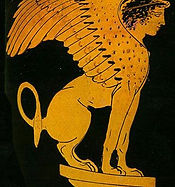SPHINX


The Sphinx is a mythical creature that comes up in both Egyptian and Greek mythology. She is said to be composed of the head of a human, the body of a lion, and in some cases, the wings of an eagle. She was described as their child by Natale Conti in Lasus 311 which talks about Echidna and her array of children. There are many variations of the Sphinx’s description, including one that states it also had the tail of a serpent. The serpent tail is attributed to Echidna, the mother, who had a serpentine body. Legend has it that the Sphinx was sent to live in Thebes, however it is unclear as to who sent her there. Some believe it was Ares out of revenge for his son, while others say it was Hera who was angry that the people had not punished Lains to her liking. Although who sent her there is unclear all stories report that it was in Thebes where she would present her riddles to the travelers. The Sphinx ate those who could not answer the riddles correctly. It is said that her evil and troublesome nature stems from the behaviors of her parents, Echidna and Typhon.
They both tended to cause harm in their own rights, so this characteristic is often embodied in their children as they follow in their parents’ footsteps. The Sphinx had terrorized the people of Thebes for so long that people from all over knew of this terrible monster. One day, Oedipus arrived and was asked to answer the Sphinx’s riddle: “What has one voice and yet becomes four-footed and two-footed and three-footed?” (“Sphinx”). To this Oedipus responded with: “man, who crawls on all four in infancy, walks on two feet when grown, and leans on a staff in old age” (“Sphinx”). To much of the Sphinx’s dismay, this was in fact the correct answer. Upon realizing Oedipus had solved the riddle, the Sphinx killed herself. Accounts of how she killed herself vary; some say she ate herself while others claim she threw herself off of the cliff where she once stood and asked her riddles. The sphinx can be seen in all different types of historical artwork, but the most well known is the Great Sphinx, located in Giza, Egypt, which depicts the Sphinx resting on her haunches. Although this is the most well known depiction, images of the Sphinx have been around for ages. Many of these can be seen on vases where the Sphinx is typically portrayed next to lions or sirens.


Oedipus and the Sphinx ca450 - 440 BC Museum of Fine Arts
Throughout time, there have been many different artistic depictions of the Sphinx. One of the most well known artistic representations is the Great Sphinx of Giza in Egypt. This depiction of the Sphinx does not include the wings of an eagle, but only the head a human and the body of a lion. However, there are many other artworks that do display the eagle wings of the Sphinx. In Egyptian mythology, the Sphinx was typically portrayed as having the body of a lion and the head of a female, usually displayed in a lying down position. When Greek mythology began portraying the Sphinx there was a clear addition of the eagle wings and, in some cases, the tail of a serpent. It was very common in ancient art for the Sphinx to appear in sculptural form or as a painting on vases.
Aside from just showing the Sphinx, there are many artworks that depict the encounter she has with Oedipus. The image to the left depicts the Sphinx alongside Oedipus as she is presenting him with her riddle. It is painted on the side of a vase and, as you can see, she is standing slightly elevated with her eagle wings somewhat spread on a large column facing Oedipus. When you look closely, you can also see that there is some sort of headband holding back the hair of the Sphinx. This painting it attributed to the Achilles Painter and dates back to ca450 - 440 BC during the classical period. The vase is currently on display at the Museum of Fine Arts in Boston, Massachusetts.